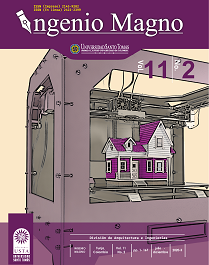Avaliação do aproveitamento energético da borra de petróleo através de um conjunto gaseificador / microturbina a gás
##plugins.themes.bootstrap3.article.main##
Resumo
Downloads
##plugins.themes.bootstrap3.article.details##
DECLARACIÓN DE ORIGINALIDAD DE ARTÍCULO PRESENTADO
Por medio del presente documento, certifico(amos) que el artículo que se presenta para posible publicación en la revista institucional INGENIO MAGNO del Centro de Investigaciones de Ingeniería Alberto Magno CIIAM de la Universidad Santo Tomás, seccional Tunja, es de mi (nuestra) entera autoría, siendo su contenido producto de mi (nuestra) directa contribución intelectual y aporte al conocimiento.
Todos los datos y referencias a publicaciones hechas están debidamente identificados con su respectiva nota bibliográfica y en las citas que se destacan como tal. De requerir alguna clase de ajuste o corrección, comunicaré(emos) de tal procedimiento con antelación a los responsables de la revista.
Por lo anteriormente expresado, declaro(amos) que el material presentado en su totalidad se encuentra conforme a la legislación aplicable en materia de propiedad intelectual e industrial de ser el caso, y por lo tanto, me(nos) hago (hacemos) absolutamente responsable(s) de cualquier reclamación relacionada a esta.
En caso que el artículo presentado sea publicado, manifiesto(amos) que cedo(emos) plenamente a la Universidad Santo Tomás, seccional Tunja, los derechos de reproducción del mismo.
Referências
S. Jafarinejad, Petroleum waste treatment and pollution control, 1st ed. Amsterdam: Elsevier Inc., 2016.
G. Hu, J. Li, and G. Zeng, “Recent development in the treatment of oily sludge from petroleum industry: A review,” J. Hazard. Mater., vol. 261, pp. 470–490, Oct. 2013
L. J. Da Silva, F. C. Alves, and F. P. De França, “A review of the technological solutions for the treatment of oily sludges from petroleum refineries,” Waste Manag. Res., vol. 30, no. 10, pp. 1016–1030, 2012
J. Liang, L. Zhao, and W. Hou, “Solid effect in chemical cleaning treatment of oily sludge,” Colloids Surfaces A Physicochem. Eng. Asp., vol. 522, pp. 38–42, 2017
E. Gomez, D. A. Rani, C. R. Cheeseman, D. Deegan, M. Wise, and A. R. Boccaccini, “Thermal plasma technology for the treatment of wastes: A critical review,” J. Hazard. Mater., vol. 161, no. 2–3, pp. 614–626, 2009
U. Arena, “Process and technological aspects of municipal solid waste gasification. A review,” Waste Manag., vol. 32, no. 4, pp. 625–639, 2012
E. A. Ocampo Batlle et al., “Thermodynamic and environmental assessment of different scenarios for the insertion of pyrolysis technology in palm oil biorefineries,” J. Clean. Prod., vol. 250, p. 119544, 2020
A. Ramos, E. Monteiro, V. Silva, and A. Rouboa, “Co-gasification and recent developments on waste-to-energy conversion: A review,” Renew. Sustain. Energy Rev., vol. 81, pp. 380–398, 2018
P. Basu, Biomass Gasification, Pyrolysis, and Torrefaction: Practical Design and Theory, 2nd ed. San Diego, CA: Elsevier Inc., 2013.
R. Tavares, E. Monteiro, F. Tabet, and
A. Rouboa, “Numerical investigation of optimum operating conditions for syngas and hydrogen production from biomass gasification using Aspen Plus,” Renew. Energy, vol. 146, pp. 1309–1314, 2020
J. Moltó, A. G. Barneto, J. Ariza, and J. A. Conesa, “Gas production during the pyrolysis and gasification of biological and physico-chemical sludges from oil refinery,” J. Anal. Appl. Pyrolysis, vol. 103, pp. 167–172, Sep. 2013
R. Ahmed, C. M. Sinnathambi, U. Eldmerdash, and D. Subbarao, “Thermodynamics analysis of refinery sludge gasification in adiabatic updraft gasifier,” Sci. World J., vol. 2014
Z. Gong, A. Du, Z. Wang, Z. Bai, and Z. Wang, “Analysis on integrated thermal treatment of oil sludge by Aspen Plus,” Waste Manag., vol. 87, pp. 512–524, 2019
J. Han et al., “Modeling downdraft biomass gasification process by restricting chemical reaction equilibrium with Aspen Plus,” Energy Convers. Manag., vol. 153, pp. 641–648, 2017
A. Martínez González, E. E. Silva Lora, and J. C. Escobar Palacio, “Syngas production from oil sludge gasification and its potential use in power generation systems: An energy and exergy analysis,” Energy, vol. 169, pp. 1175–1190, 2019
M. Ashizawa, S. Hara, K. Kidoguchi, and J. Inumaru, “Gasification characteristics of extra-heavy oil in a research-scale gasifier,” Energy, vol. 30, no. 11-12 SPEC. ISS., pp. 2194–2205, 2005
Y. Castillo Santiago, A. Martínez González, O. J. Venturini, and D.
M. Yepes Maya, “Assessment of the energy recovery potential of oil sludge through gasification aiming electricity generation,” Energy, vol. 215, p. 119210, 2021
Capstone, “Capstone C200 Microturbine Technical Reference,” Los Ángeles, California, 2009.
L. P. L. M. Rabou, J. M. Grift, R. E. Conradie, and S. Fransen, “Micro Gas Turbine Operation with Biomass Producer Gas and Mixtures of Biomass Producer Gas and Natural Gas,” Energy & Fuels, vol. 22, no. 3, pp. 1944–1948, May

